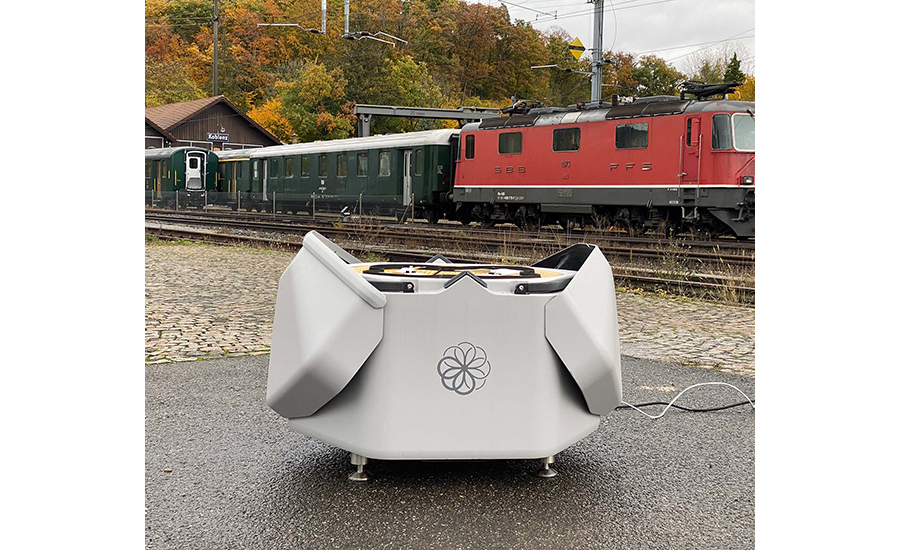A trio of emerging technologies has been the focus of increasing attention recently, both in public circles and in private industries such as commercial security. As the trend toward autonomous security unfolds, customer demand for surveillance drones, security robots and airspace security systems (drone detection and monitoring) may eventually affect many more security integrators than it does today. Some matters that integrators should keep a watchful eye on are new system introductions, end-user adoption of these technologies to address threats, and laws and regulations that impact how these systems are used.
Security integrators are at various stages of everything from learning about robot and drone-based solutions to reselling them. Some are fully onboard with one or more, having already made several impactful sales; while others are still exploring the technologies and how they might make a viable business opportunity. One aspect that weighs prominently are the myriad regulations for the use of, particularly, drones. Integrators want more direction on how to deploy and use them for security, as well as updated legislation about what can be done once a suspicious drone is detected.
Convergint Looking at Autonomous Solutions
Schaumburg, Ill.-based Convergint, a global integrator ranked No. 1 on SDM’s 2023 Top Systems Integrators Report, is currently engaged only in drone detection, but anticipates also selling security robots and surveillance drones by the end of this year.
Most of Convergint’s drone detection sales have been in the correctional industry segment (although demand is growing from utilities, ports, oil and gas sites, etc.), because contraband delivery using drones is a significant threat, says Scott Frigaard, Convergint’s digital transformation autonomous lead. The contraband being delivered includes drugs, weapons, cell phones, tobacco and other similar items.
Frigaard describes the contraband-via-drone operators as “very sophisticated, very profitable enterprises.” As new detection solutions and mitigation tactics are introduced, the drone operators quickly adapt by flying drones from manufacturers that aren’t included in a detection system’s “library” of detectable devices, or by using homemade drones that don’t send any wireless communication.
“Most of the customers we talk to still don’t understand that there are limitations on what they’re able to do. The first question we usually get is, ‘I know I’m getting drones over my chemical facility. I want to shoot them down.’ We have to work them through what the reality of response capabilities are.”
— Scott Frigaard, Convergint
Convergint has seen an increase drone size, which increases their payload capacity. They have also seen more swarm attacks, which means additional drones are introduced into the airspace until the detection system can no longer track the drone carrying the payload. Another tactic is operators will fly decoy drones to one part of a facility to distract corrections officers and then drop the payload in another part.
“It is a constantly evolving threat scenario,” Frigaard says.
In these applications in the United States, once a nefarious drone is detected, there are more actions that cannot be taken than can be. There are some instances in the U.S. where a counter-uncrewed aerial system (C-UAS) can be used, but that is in the hands of the federal government Department of Justice and other federal entities with authority to designate SEAR 1 through 5 events, and those are usually critical infrastructure or Department of Defense sites, explains Bill Edwards, chair of Security Industry Association’s Counter-UAS working group and president of federal and public safety at Building Intelligence, New York.
“C-UAS systems can be employed in the U.S., but only under specific circumstances that are approved by the government. A stadium that’s hosting 60,000 people at a football game right now does not have the authority to use a C-UAS technology unless that stadium has been designated as a SEAR event,” Edwards says.
SIA has set three legislative objectives that methodically approach this issue in a reasonable and responsible manner and give legislators a clear path to authorizing C-UAS beyond what is currently approved, Edwards says.
In part because of this regulatory backdrop, drone detection solutions often utilize limited mitigation tactics. Frigaard, for example, says, “The mitigation tactic that we help customers deploy is the ability to locate the drone operator who is illegally flying it, dispatch law enforcement to them, and then allow law enforcement to take care of that threat.” The solution from Convergint’s drone-detection partner uses RF sensors around a facility to trilateralize the location of the drone operator, he says.
In the realm of marketing these newer solutions, Convergint produces industry-specific webinars and helps clients identify funding sources, such as a port security grant from DHS because drone detection is part of the capabilities that are covered by those funds, he says. The company also has written and published a long-form e-book for the corrections industry on different aspects of drone detection, such as selecting and implementing a solution and which processes need to be adapted.
“We’re currently in the process of developing a paid pilot program for the humanoid robots and expanding on the paid pilot program for indoor drones in select end-user facilities across the country.”
— Jay Linton, ADT
Convergint is also exploring security solutions that are autonomous, including solutions that will allow remote guarding and patrol-and-response duties to be handled by drones and robots that can be managed by a centralized security operations center, Frigaard explains. “Ideally, solutions would not have an operator have to drive a drone or a robot. We want that to be completely automated whereby it automatically patrols, automatically responds.
“As robots and drones themselves become more autonomous, I think they will be much more attractive for human guard replacement, as well as just more effective solutions. If a customer has a very large perimeter, flying a drone may be a much more cost-effective solution than installing video surveillance along the perimeter and gives greater capabilities,” Frigaard says. “You can have color and thermal cameras within the drone payload. You can fly multiple drones, you can fly multiple altitudes, and then you can follow things. I think that as they become more autonomous, they will become more widely adopted.”
ADT Introduces EvoGuard Brand
At this year’s CES 2023 show, ADT Commercial, Boca Raton, Fla., unveiled its EvoGuard intelligent autonomous guarding solutions brand. The offering includes both independent humanoid robots and autonomous indoor drones. ADT says it is collaborating with its Norwegian innovation partner, 1X, on the humanoid robot and with Israel-based Indoor Robotics on the Tando autonomous indoor drone.
“But this definitely isn’t a singular endeavor for us,” says Paul Yezzi, director, business development for national accounts at ADT. “Beyond the EvoGuard suite of solutions, we are also in the process of evaluating additional solutions to address other areas of customer concern, and to expand our EvoGuard intelligent autonomous solutions portfolio into outdoor spaces.”
The company recently completed its first EvoGuard pilot sale, selling the Tando autonomous indoor drone to its existing pilot partner — the luxury Swiss watchmaker, Movado — to continue field-testing the solution in their distribution center.

“We’re currently in the process of developing a paid pilot program for the humanoid robots and expanding on the paid pilot program for indoor drones in select end-user facilities across the country,” says Jay Linton, ADT’s vice president, strategic alliances.
Based on conversations with current pilot partners and prospects, Yezzi says, ADT Commercial is finding that these types of solutions have the potential to be applied in any vertical or commercial facility where there is a need for a guard force — particularly if there are mundane, monotonous tasks involved.
“For example, in the case of Movado, they’ve been testing the indoor drones at their distribution center in New Jersey since June 2022. Their team has been actively field-testing the technology in collaboration with us and Indoor Robotics to serve as a supplemental physical security measure for overnight and weekend coverage,” Linton says. He adds that this customer anticipates the solution will help it “better utilize technology and streamline labor costs.”
Any commercial facilities that are currently staffing with traditional security guards is a possibility for these technologies — not as a means of replacing all guards, but to replace or supplement some guard services and add a new element of protection to corporate security programs, Yezzi believes.
“We’re also seeing increased interest for robots and indoor drones in market segments and facilities where there’s a need to minimize human interaction with certain areas or where traditional cameras can’t be used,” Linton describes. This could include facilities containing highly sensitive intellectual property or areas such as datacenters, where human error or unauthorized interaction could be dangerous or disruptive to operations, he says.
“Given that context, deploying robots and drones can be extremely appealing to these organizations. It’s putting technology first — over a human — to serve as a roving set of eyes to review a security incident and help to inform a response,” Linton says.
Now that ADT has entered the field-testing and piloting phase of its EvoGuard business, it is engaged in a multi-channel marketing, advertising and earned media strategy. This includes trade show exhibits and demos, a web presence and sales collateral, multimedia content, strategic media engagement, and advertisements. ADT also has created thought-leadership articles and white papers to educate early adopters on the trends in the use of robots and drones in the security space.
“We’re also investing in and building out our Innovation Lab in Dallas. This dedicated space will allow us to keep taking chances, testing out new technologies and features, but also offers us the opportunity to invite customers and prospects in to experience the solutions and see them in action,” Linton describes.
Smaller Integrators Testing the Waters
Advantech, a division of the Cook & Boardman Group, based in Dover, Del., and a Security-Net integrator, has spent the majority of its research and development in the drone detection space because it’s where it has clients with the most interest.

“In reality though, beyond that we haven’t delivered any projects in that segment,” says Dave Sweeney, Advantech’s general manager. “We’ve delivered a few proposals, done quite a bit of education in the market in our geography, but haven’t delivered any business.”
Sweeney offers three theories for why Advantech has faced hurdles in selling drone detection systems to its customers:
- The federal government’s inability or failure to provide enhanced regulation and/or direction on drone technologies.
- In certain cases, the manufacturers have partnered directly with the end users to deliver the technology.
- The price point is very expensive versus the perceived risk.
Sweeney believes that these factors, particularly regulations, are causing some people to wait in hope that there may be enhancements to the existing regulations in the future. “I think that the government’s inability to act or react to this threat or this risk is kind of impacting the end users’ ability to deploy technology,” Sweeney says.
Sweeney explains that there are few actions end users can take when they detect a drone in their airspace. In countries outside of the U.S., end users can take countermeasures such as deploying jammers, taking down the drone or confiscating it. They are able to react with a few more options than someone legally is able to use in the U.S., he says.
“In the drone detection world, all we’re offering for a relatively sizable investment is the ability to identify that there’s an unidentified drone in the airspace,” Sweeney describes. In the correctional market, for example, because the threat of a drone is to drop contraband over the fence, the primary “countermeasure” that can be taken is to close all the yards, wait for the drone to leave, then search the yards to find the contraband.
Although the technology exists to potentially identify the drone pilot’s location, attempting to catch the pilot before the pilot is gone is hard to do, Sweeney emphasizes. “Most drones have a battery life of 20 to 30 minutes, so that’s your reaction time if your goal is to capture the pilot who may be up to a mile away,” he says.
In Advantech’s case, their prospective clients did not purchase systems elsewhere. “The client chose not to invest in the technology at this time. I don’t consider that truly lost because the risk hasn’t gone away. At some point in time, the client is still going to have to evaluate that risk and potentially make an investment as the risk grows,” Sweeney says.
Houston-based Preferred Technologies (Pref-Tech), which focuses solely on enterprise-level customers, has had a similar experience to Advantech. Its only sale thus far has been a surveillance drone the company purchased for a local law enforcement agency through its State of Texas DIR contract, a direct cooperative purchasing contract that allows Pref-Tech to sell certain products to government agencies with a pre-negotiated discount off MSRP, without having to go through a three-bid process.
One of the challenges is funding, notes Elliott Gabriel, sales and design professional at Pref-Tech. “It’s end users understanding the value and being able to sell that internally to either their leadership or their procurement group,” he says.
“Counter-UAS systems can be employed in the U.S., but only under specific circumstances that are approved by the government. A stadium that’s hosting 60,000 people at a football game right now does not have the authority to use a C-UAS technology unless that stadium has been designated by the Department of Homeland Security as a SEAR event.”
— Bill Edwards, Building Intelligence
Pref-Tech’s other challenges to sales are technology-related, Gabriel says. Integration with the user’s video management system is one potential challenge in making sure that both systems are compatible. “Bringing that video back live is a technological challenge, no different than body-worn cameras having that challenge of being able to live-stream back, if that is what’s needed,” Gabriel says.
In addition, he highlights FAA requirements of having a person licensed to physically crew or fly the drone. “Having the personnel on staff that is qualified and certified to use that is another potential barrier. If there’s no one currently on the staff, then the end-user customer must dedicate someone to get those licenses and certifications to do that,” he advises.
Just a Matter of Time
Despite the hurdles to sales and other challenges, these security integrators think security robots, surveillance drones, and drone detection will have a place in the security industry in the future.
Both aerial and terrestrial drones may prove useful in security, Gabriel remarks. “Imagine if there was a drone on land that could physically walk around the perimeter of a jail; that would alleviate the need to have one of their staff members walk around outside in the dark with that risk,” he suggests. He doesn’t ever see the human element being removed from security, but he also thinks the artificial intelligence (AI) side of security is very important because it “can navigate information much faster than the human can,” he says.
The viability of these technologies as a security offering also will hinge on connectivity, Gabriel believes. He says the widespread deployment of 5G will be the predecessor task required for certain technologies such as drones to be effective, both for transmission of the video as well as control of the device.
Sweeney sees that certain end users, such as airports, can quantify the investment in a technology such as drone detection based on their cost to shut down operations in the event of a drone in the air domain. For other end users, however, quantification of such an investment isn’t as easy at this time.
“So, I think that there will be an opportunity for someone. I don’t see drones becoming less prevalent and I don’t see drones becoming less capable — and I also don’t see the technology solutions for countermeasures and detection diminishing. I see them growing,” Sweeney says. “I see the companies growing, I see the offerings becoming more mature. It’s just a matter of time of finding kind of that sweet spot where the risk justifies the investment.”




